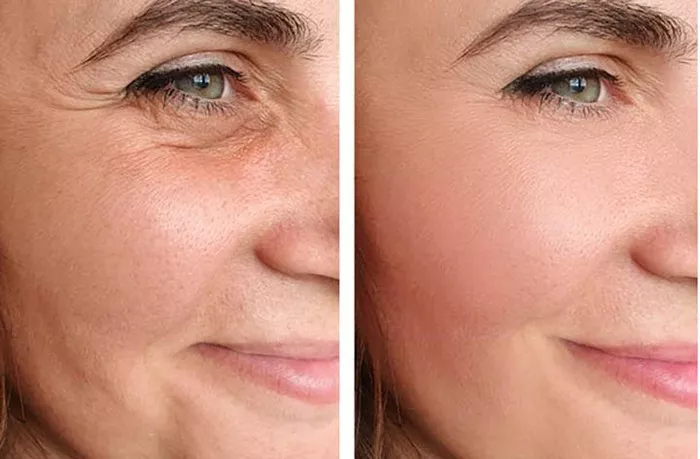Smile lines, also known as nasolabial folds, are the lines that extend from the sides of the nose to the corners of the mouth. While these lines are a natural part of facial expression, they can become more pronounced with age, sun exposure, and repetitive facial movements. If you’re looking for ways to reduce smile lines and achieve a smoother, more youthful appearance, this article will explore effective strategies to help you achieve your goal.
Understanding Smile Lines
Before we delve into the strategies to reduce smile lines, it’s important to understand what causes them. Nasolabial folds occur due to a combination of factors:
Natural Aging Process: As we age, the skin’s production of collagen and elastin decreases. Collagen provides structural support to the skin, while elastin helps maintain its elasticity. The loss of these proteins leads to the formation of wrinkles and the deepening of nasolabial folds.
Repeated Facial Expressions: Constant movement of the facial muscles, particularly smiling, can contribute to the development of smile lines over time. The repeated folding of the skin in the nasolabial area can cause creases to become more pronounced.
Sun Exposure: Prolonged sun exposure accelerates the breakdown of collagen and elastin in the skin. UV rays damage the skin’s underlying structures, leading to the formation of wrinkles, including smile lines.
Strategies to Reduce Smile Lines
While it’s not possible to completely eliminate smile lines, several strategies can help minimize their appearance and prevent further deepening. Here are some effective approaches:
Topical Retinoids
Retinoids, derived from vitamin A, are known for their anti-aging properties. These topical treatments stimulate collagen production and promote cell turnover, resulting in smoother skin. Regular use of retinoid creams or serums can help reduce the visibility of smile lines over time. However, it’s important to follow the instructions provided by a dermatologist and be patient, as results may take several weeks or months to become noticeable.
Moisturization
Keeping the skin well-hydrated is crucial for maintaining its elasticity and plumpness. Moisturizers with ingredients like hyaluronic acid, glycerin, and ceramides can help hydrate the skin, reducing the appearance of smile lines. Apply moisturizer daily, both in the morning and at night, after cleansing your face.
Sun Protection
Protecting your skin from the harmful effects of the sun is essential for preventing further damage and minimizing the visibility of smile lines. Use a broad-spectrum sunscreen with an SPF of 30 or higher and apply it generously to your face and exposed areas every day. Additionally, wear protective clothing and seek shade during peak sun hours.
Facial Exercises
Certain facial exercises can help strengthen the muscles around the mouth and improve skin elasticity. Regularly performing exercises like cheek lifts, cheek puffing, and smiling while pressing your fingers against the smile lines can help reduce their prominence. However, consult with a facial exercise specialist or physical therapist to ensure you’re performing the exercises correctly and safely.
Dermal Fillers
Injectable dermal fillers can effectively soften the appearance of smile lines by adding volume and plumpness to the affected area. These fillers are typically made of hyaluronic acid, a substance naturally found in the body. The procedure involves injecting the filler into the skin, and the results can last from several months to over a year, depending on the specific filler used. It’s essential to consult with a qualified dermatologist or cosmetic surgeon to determine the most suitable filler and ensure safe administration.
Chemical Peels
Chemical peels involve applying a chemical solution to the skin, which exfoliates the top layer and stimulates collagen production. This procedure can improve the appearance of smile lines by promoting skin rejuvenation and reducing the depth of wrinkles. It’s recommended to have a professional perform chemical peels to ensure the proper concentration and application for your specific skin type and needs.
Laser Resurfacing
Laser resurfacing treatments use concentrated beams of light to target and remove damaged skin cells, stimulating collagen production in the process. This procedure can help reduce the visibility of smile lines and improve overall skin texture. Laser resurfacing should be performed by a skilled dermatologist or cosmetic surgeon to achieve optimal results and minimize the risk of complications.
Microneedling
Microneedling involves using a device with tiny needles to create controlled micro-injuries in the skin. This process stimulates collagen production and enhances skin rejuvenation. Regular microneedling treatments can help minimize the appearance of smile lines and improve overall skin texture. It’s advisable to have this procedure performed by a trained professional to ensure safety and effectiveness.
Conclusion
While smile lines are a natural part of facial expression and aging, there are several strategies available to help reduce their visibility. From topical retinoids and moisturization to sun protection and professional treatments like dermal fillers and chemical peels, these approaches can effectively minimize the appearance of smile lines and promote a more youthful-looking complexion. It’s important to remember that results may vary depending on individual factors, and consulting with a dermatologist or skincare professional is crucial to determine the most suitable treatment options for your specific needs. Additionally, maintaining a healthy lifestyle, including a balanced diet, regular exercise, and adequate hydration, can contribute to overall skin health and the reduction of smile lines. Embrace the natural beauty of your smile while taking proactive steps to care for your skin and maintain a youthful glow.


